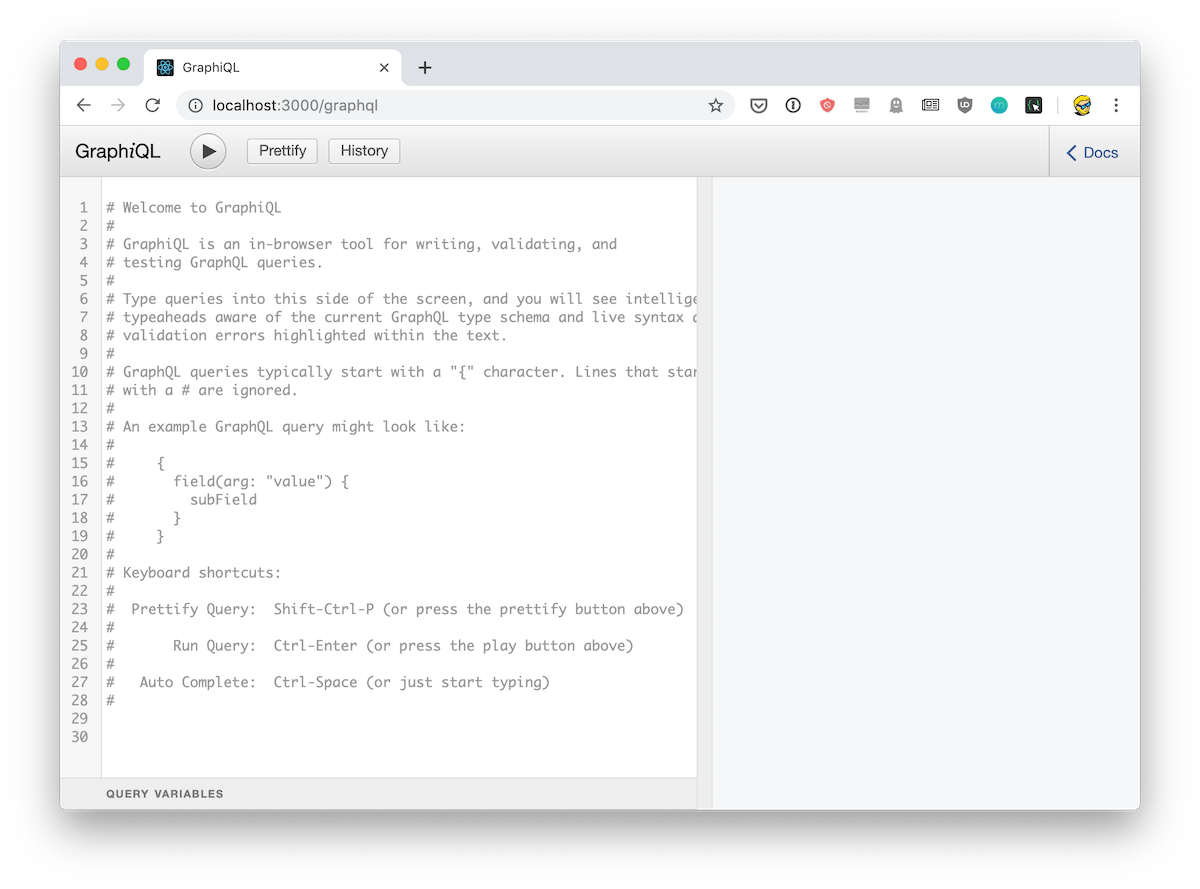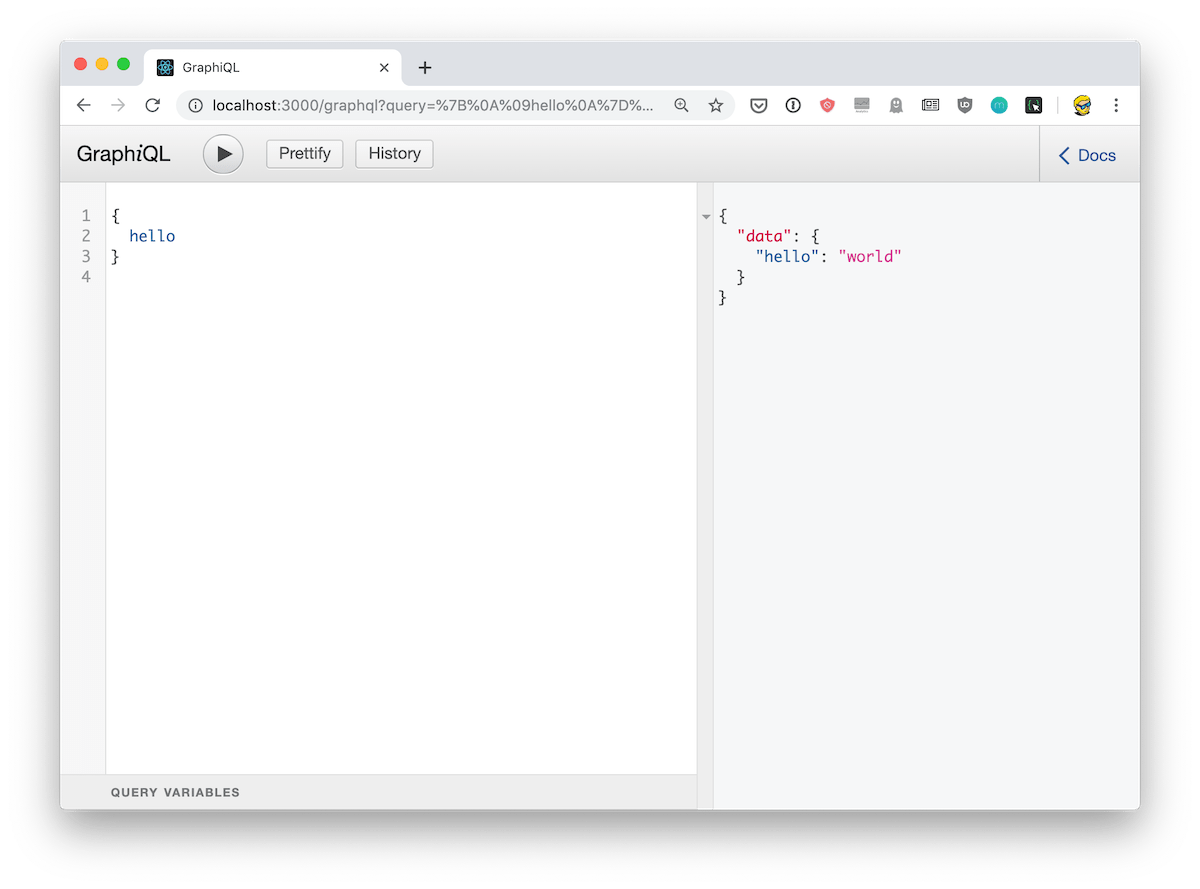How to create a GraphQL Server with Node.js and Express
A simple tutorial on how to create a Node.js and Express powered GraphQL server
Start by creating a new Node.js project, if you haven’t one already set up:
npm init --yThis command creates the package.json file we need to work with npm.
Install the npm packages express, graphql and express-graphql:
npm install express graphql express-graphqlCreate an app.js file, and let’s start with the initializing the Express server:
const express = require('express')
const app = express()
app.listen(3000, () => {
console.log('App listening on port 3000')
})Now we add express-graphql. This is a middleware, and we apply it to just a route, the /graphql route:
const express = require('express')
const graphqlHTTP = require('express-graphql')
const app = express()
app.use('/graphql', graphqlHTTP())
app.listen(3000, () => {
console.log('App listening on port 3000')
})We must pass an object which contains the schema property, which must contain a schema definition.
We must define a schema first!
Create a schema.js file, and in there we first require graphql, then using the object destructuring syntax we get the GraphQLSchema, GraphQLObjectType and GraphQLString objects we’ll soon need to use:
const graphql = require('graphql')
const { GraphQLSchema, GraphQLObjectType, GraphQLString } = graphqlThen we define the schema value by initializing a new GraphQLSchema instance, passing an object which contains a query property. This property is an instance of a GraphQLObjectType object:
const schema = new GraphQLSchema({
query: new GraphQLObjectType({
//...
}),
})
module.exports = schemaInside this new object we must specify a name, and a fields parameters. This last property is an object which contains a set of properties, one for each field of our schema. In this example we set up an hello field:
const schema = new GraphQLSchema({
query: new GraphQLObjectType({
name: 'RootQueryType',
fields: {
hello: {
type: GraphQLString,
resolve() {
return 'world'
},
},
},
}),
})The resolve() method returns the string world, which means that when we will ask for the hello field, we’ll get that string back.
Here is the full schema.js file content:
const graphql = require('graphql')
const { GraphQLSchema, GraphQLObjectType, GraphQLString } = graphql
const schema = new GraphQLSchema({
query: new GraphQLObjectType({
name: 'RootQueryType',
fields: {
hello: {
type: GraphQLString,
resolve() {
return 'world'
},
},
},
}),
})
module.exports = schemaNow let’s go back to our app.js file.
This is what we had:
const express = require('express')
const graphqlHTTP = require('express-graphql')
const app = express()
app.use('/graphql', graphqlHTTP())
app.listen(3000, () => {
console.log('App listening on port 3000')
})We now require the schema.js file:
const schema = require('./schema.js')and we add that in an object we pass to the graphqlHTTP() constructor:
app.use(
'/graphql',
graphqlHTTP({
schema: schema,
})
)Ok!
We can now test this and see if it works. We can use GraphiQL, a great tool to test our GraphQL API.
It’s already installed and to enable that, we need to pass another property to the graphqlHTTP constructor:
app.use(
'/graphql',
graphqlHTTP({
schema: schema,
graphiql: true,
})
)Now after you run node app.js, accessing the http://localhost:3000/graphql URL with the browser you’ll see GraphiQL in action:

And you can test the first API call, passing this query:
{
hello
}This is the result:

Let’s now build a more complex schema.
One that has nested types.
An example I have in mind is a blog post.
A blog post has a title, a description, and it also has an author. The author has a name.
Let’s figure this out.
First we add the set of posts and authors:
const posts = [
{
title: 'First post',
description: 'Content of the first post',
author: 'Flavio',
},
{
title: 'Second post',
description: 'Content of the second post',
author: 'Roger',
},
]
const authors = {
Flavio: {
name: 'Flavio',
age: 36,
},
Roger: {
name: 'Roger',
age: 7,
},
}This is where we’ll get the data from.
Next, we define 3 GraphQLObjectType instances:
authorType, which defines the author datapostType, which defines the post dataqueryType, the main one
Let’s start with the author. An author has a name and an age.
We use the GraphQLInt type, which we must add to the require:
const { GraphQLSchema, GraphQLObjectType, GraphQLString, GraphQLInt } = graphql
//...
const authorType = new GraphQLObjectType({
name: 'Author',
fields: {
name: {
type: GraphQLString,
},
age: {
type: GraphQLInt,
},
},
})Next is postType. A post has a title, a description (both strings) and an author. An author is of type authorType, which we just defined, and it has a resolver.
We get the author name from the source parameter, which is the params passed to the post object, and we lookup the author data based on that. We return it.
const postType = new GraphQLObjectType({
name: 'Post',
fields: {
title: {
type: GraphQLString,
},
description: {
type: GraphQLString,
},
author: {
type: authorType,
resolve: (source, params) => {
return authors[source.author]
},
},
},
})Note that a resolver function can be async, so you can use async/await to lookup resources from a database or the network.
Next up is queryType, the root type we’ll add to the schema. In there, we define 2 fields:
posta single blog post, identified by an idpoststhe list of posts
both of them have a resolver function to lookup the data in the posts array:
const queryType = new GraphQLObjectType({
name: 'Query',
fields: {
post: {
type: postType,
args: {
id: { type: GraphQLInt },
},
resolve: (source, { id }) => {
return posts[id]
},
},
posts: {
type: new GraphQLList(postType),
resolve: () => {
return posts
},
},
},
})Notice the new GraphQLList type, which we use to wrap postType to mean that it’s a list of postType objects. We must require it on top:
const {
GraphQLSchema,
GraphQLObjectType,
GraphQLString,
GraphQLList,
GraphQLInt,
} = graphqlThat’s it. We need to add it to our schema and we are set:
const schema = new GraphQLSchema({
query: queryType,
})Here’s the full code:
const graphql = require('graphql')
const {
GraphQLSchema,
GraphQLObjectType,
GraphQLString,
GraphQLList,
GraphQLInt,
} = graphql
const posts = [
{
title: 'First post',
description: 'Content of the first post',
author: 'Flavio',
},
{
title: 'Second post',
description: 'Content of the second post',
author: 'Roger',
},
]
const authors = {
Flavio: {
name: 'Flavio',
age: 36,
},
Roger: {
name: 'Roger',
age: 7,
},
}
const authorType = new GraphQLObjectType({
name: 'Author',
fields: {
name: {
type: GraphQLString,
},
age: {
type: GraphQLInt,
},
},
})
const postType = new GraphQLObjectType({
name: 'Post',
fields: {
title: {
type: GraphQLString,
},
description: {
type: GraphQLString,
},
author: {
type: authorType,
resolve: (source, params) => {
return authors[source.author]
},
},
},
})
const queryType = new GraphQLObjectType({
name: 'Query',
fields: {
post: {
type: postType,
args: {
id: { type: GraphQLInt },
},
resolve: (source, { id }) => {
return posts[id]
},
},
posts: {
type: new GraphQLList(postType),
resolve: () => {
return posts
},
},
},
})
const schema = new GraphQLSchema({
query: queryType,
})
module.exports = schemaSee the complete code on Glitch.
download all my books for free
- javascript handbook
- typescript handbook
- css handbook
- node.js handbook
- astro handbook
- html handbook
- next.js pages router handbook
- alpine.js handbook
- htmx handbook
- react handbook
- sql handbook
- git cheat sheet
- laravel handbook
- express handbook
- swift handbook
- go handbook
- php handbook
- python handbook
- cli handbook
- c handbook
subscribe to my newsletter to get them
Terms: by subscribing to the newsletter you agree the following terms and conditions and privacy policy. The aim of the newsletter is to keep you up to date about new tutorials, new book releases or courses organized by Flavio. If you wish to unsubscribe from the newsletter, you can click the unsubscribe link that's present at the bottom of each email, anytime. I will not communicate/spread/publish or otherwise give away your address. Your email address is the only personal information collected, and it's only collected for the primary purpose of keeping you informed through the newsletter. It's stored in a secure server based in the EU. You can contact Flavio by emailing flavio@flaviocopes.com. These terms and conditions are governed by the laws in force in Italy and you unconditionally submit to the jurisdiction of the courts of Italy.